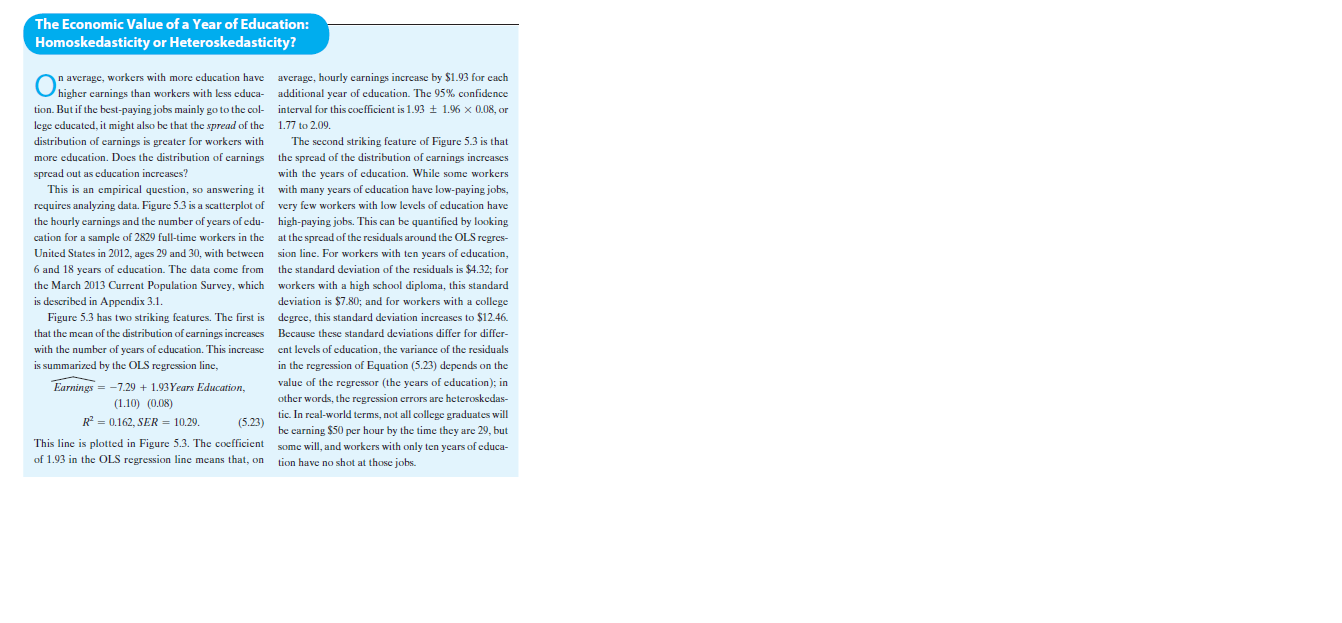
Concept explainers
Read the box “The Economic Value of a Year of Education: Homoskedasticity or Heteroskedasticity?” in the Attachment. Use the regression reported in Equation to answer the following.a. A randomly selected 30-year-old worker reports an education levelof 16 years. What is the worker’s expected average hourly earnings?b. A high school graduate (12 years of education) is contemplatinggoing to a community college for a 2-year degree. How much is thisworker’s average hourly earnings expected to increase?c. A high school counselor tells a student that, on average, college graduates earn $10 per hour more than high school graduates. Is this statement consistent with the regression evidence? What

Trending nowThis is a popular solution!
Step by stepSolved in 3 steps with 5 images

- Identify the correct statement concerning, r the correlation coefficie between X and Y and the linear regression, Y = aX+b. A. Both can be used to show cause and effect. B. Both quantify the strength of relationship between X and Y. C. X and Y are interchangeable in both relationships. D. Both can be used to make predictions.arrow_forwardSimple linear regression model helps to adjust out the effects of confounding factors in a statistical analysis. A. TrueB. FalseC. None of the above choicesarrow_forwardUsing the previous regression model, what salary would you expect a student with a 3.1 GPA to expect? Round your answer to 1 decimal and express in $1,000's (same format the Salary variable has in the Excel dataset).arrow_forward
- Prices and mileage of 48 Dodge 2500 Pickup trucks with Cummins diesel engines. Prices ranged from $28,925 to $68,650. Mileage ranged from 315 to 186,466. While I did not share the trucks were 2013 to 2020 models. Please show all work. Interpret b0 in the context of this problem. Interpret b1 in the context of this problem. What percent of total variation in prices is explained by the regression model? Provide evidence to support your answer. Price Mileage 52293 34450 50987 23372 62988 21738 37500 81176 66000 23118 47601 71143 47750 18214 42000 32303 50987 23372 28925 143737 42050 58561 51738 9691 51500 23969 44988 48781 29500 114809 46975 16918 63999 15507 46975 16918 43222 50459 38386 87192 42000 68722 62250 14042 62998 21738 32130 103644 52293 34450 52900 68883 53172 3656 53494 315 39594 88441 63246 23631 58250 34974 59391 18383 50650 42737 54976 84200 68650 14401 51114 47433 43900 74106 37450…arrow_forwardSuppose a new location opens in an area with a population of 144,000, an average income of$36,000, an average age of 27, and $2,000 spent on advertising in the previous month.a. Use your chosen regression to predict Gross Sales for the month at the new location. (I picked population)b. Suppose actual Gross Sales for the month were $420,624. Does this make sense,given your model and predicted value?12. Using your chosen regression model,a. Identify the slope and explain what it means, in the context of the model.b. Identify the initial value or y-intercept and explain what it means, in the context ofthe model.arrow_forward50arrow_forward
- 2. Participants were kept awake for a certain number of hours before given a visuospatial task. Researchers measured how many correct responses each participant had. Results are shown below. Use alpha = .01. Number of Correct Hours Kept Awake (X) Responses (Y) 21 X = 10 SS, = 422 Y = 10 SS, = 690 2 4 19 %3D 6. 13 SPxy =-525 ху 5 20 S, =5.70 S, = 7.29 9. 11 10 9. 14 5 15 5 17 2 18 1 17 1 13 4 18 8 11 A. Graph the data. B. State the hypotheses. C. Make a decision about the null. a. Calculate Pearson's r i. Decision about null hypothesis? b. Calculate effect size i. Interpret effect size. D. State your conclusion. E. Relate your conclusion to the research. F. Calculate the regression formula. G. If someone was kept awake for 9 hours, what is the predicted number of correct responses?arrow_forward2arrow_forwardConstruct and interpret a 95% prediction interval for the proceeds when the number of issues is 658.arrow_forward
 MATLAB: An Introduction with ApplicationsStatisticsISBN:9781119256830Author:Amos GilatPublisher:John Wiley & Sons Inc
MATLAB: An Introduction with ApplicationsStatisticsISBN:9781119256830Author:Amos GilatPublisher:John Wiley & Sons Inc Probability and Statistics for Engineering and th...StatisticsISBN:9781305251809Author:Jay L. DevorePublisher:Cengage Learning
Probability and Statistics for Engineering and th...StatisticsISBN:9781305251809Author:Jay L. DevorePublisher:Cengage Learning Statistics for The Behavioral Sciences (MindTap C...StatisticsISBN:9781305504912Author:Frederick J Gravetter, Larry B. WallnauPublisher:Cengage Learning
Statistics for The Behavioral Sciences (MindTap C...StatisticsISBN:9781305504912Author:Frederick J Gravetter, Larry B. WallnauPublisher:Cengage Learning Elementary Statistics: Picturing the World (7th E...StatisticsISBN:9780134683416Author:Ron Larson, Betsy FarberPublisher:PEARSON
Elementary Statistics: Picturing the World (7th E...StatisticsISBN:9780134683416Author:Ron Larson, Betsy FarberPublisher:PEARSON The Basic Practice of StatisticsStatisticsISBN:9781319042578Author:David S. Moore, William I. Notz, Michael A. FlignerPublisher:W. H. Freeman
The Basic Practice of StatisticsStatisticsISBN:9781319042578Author:David S. Moore, William I. Notz, Michael A. FlignerPublisher:W. H. Freeman Introduction to the Practice of StatisticsStatisticsISBN:9781319013387Author:David S. Moore, George P. McCabe, Bruce A. CraigPublisher:W. H. Freeman
Introduction to the Practice of StatisticsStatisticsISBN:9781319013387Author:David S. Moore, George P. McCabe, Bruce A. CraigPublisher:W. H. Freeman





